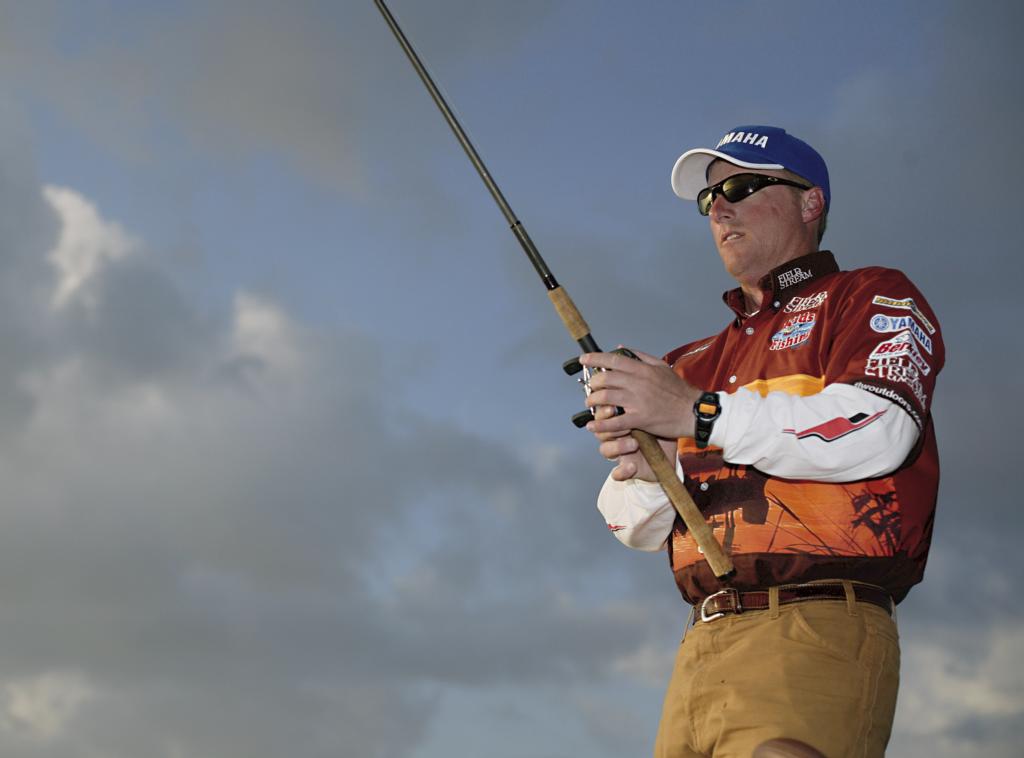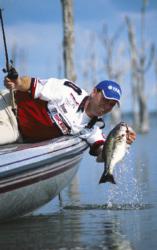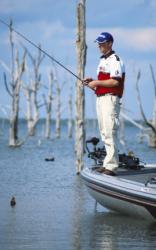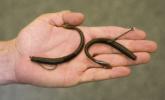Postspawn protocol
The spawn is over, bass are in transition and the bite is heating up.

Like most bass fishermen, you probably started the season by picking off hungry, prespawn bass with everything from jigs to jerkbaits as they migrated from main lake ledges to shallow spawning areas. Then came the thrill of sight-fishing for heavy female bass as they hovered over their beds like blimps.
No question about it, the prespawn and spawning phases were fun while they lasted. But now you’re struggling. The spawn is over, and the bass have vanished into a Twilight Zone between the spawn and their summer feeding patterns. The general consensus among anglers is that the bass are lethargic and unwilling to bite because they’re worn out from the rigors of reproduction.
When you consider that this transitional phase lasts for weeks, you had better make the right choices about where and how to fish. If you don’t, you’ll have your hat handed to you at the next tournament. According to Todd Faircloth and Kelly Jordon, two standout anglers on the Wal-Mart FLW Tour, the major adjustment needed is in your head. They claim the postspawn funk is a myth.
“A lot of people think postspawn fish are hard to catch,” Faircloth says. “The truth is that they come off the beds hungry and ready to feed. It’s really one of the better times to catch bass.”
Don’t be fooled by little buck bass guarding fry in spawning areas. The females, for the most part, have vacated the beds. But, they may not be far away. Jordon says the postspawn phase is almost a reverse of the prespawn, with the bass heading out instead of in.
“They may be as close as the first subtle drop near the spawning beds,” he says. “They also stop to feed at secondary points and on flats, typically 6 feet or shallower.”
 Exactly where postspawn bass set up a temporary residence depends on what a given lake has to offer. In many cases they relate to flooded bushes, docks and other visible cover between their spawning grounds and main-lake structures. Faircloth stays out of shallow, protected, spawning pockets at this time and checks isolated cover on secondary points. On Sam Rayburn, his home lake, flooded bushes often hold the bass.
Exactly where postspawn bass set up a temporary residence depends on what a given lake has to offer. In many cases they relate to flooded bushes, docks and other visible cover between their spawning grounds and main-lake structures. Faircloth stays out of shallow, protected, spawning pockets at this time and checks isolated cover on secondary points. On Sam Rayburn, his home lake, flooded bushes often hold the bass.
Though the bass are in a feeding mode, they’ve endured heavy fishing pressure during the previous weeks and don’t respond well if you crowd them. Faircloth backs off the bushes a comfortable casting distance and slings a 5-inch Yamamoto Cut Tail Worm to the cover with a 7-foot medium-action rod and 12-pound Berkley Sensation monofilament. He Texas rigs the worm with a 3/0 straight-shank hook and a 1/8-ounce bullet sinker.
If bass shun the Texas rig, he fishes the Cut Tail Worm wacky style with a finishing nail in the worm’s head to make it stand on end. He goes with colors like watermelon red when the sun is up and June bug when it’s overcast.
“With the Texas rig, 75 percent of the bites come on the initial fall,” Faircloth says. “That goes up to 90 percent when I’m fishing the wacky worm.”
 If he doesn’t get any takers as the worm drops, Faircloth works the bait over the bottom, 5 to 6 feet away from the cover. Then he quickly reels in and casts to another target. He uses the same presentation when he fishes flats covered with scattered grass, such as hydrilla, pepper grass or eel grass. He also fishes a Yamamoto Senko in this situation. Many productive flats are located inside major creeks before you reach the spawning pockets. Most of Faircloth’s strikes come when he casts next to patches of grass or to holes in larger grass beds.
If he doesn’t get any takers as the worm drops, Faircloth works the bait over the bottom, 5 to 6 feet away from the cover. Then he quickly reels in and casts to another target. He uses the same presentation when he fishes flats covered with scattered grass, such as hydrilla, pepper grass or eel grass. He also fishes a Yamamoto Senko in this situation. Many productive flats are located inside major creeks before you reach the spawning pockets. Most of Faircloth’s strikes come when he casts next to patches of grass or to holes in larger grass beds.
Jordon fishes similar soft-plastic baits on points and flats during the postspawn and adds a 5-inch Lake Fork Tackle Magic Shad to his arsenal. “You can really walk the dog with that bait,” he says. “I rig it with a 5/0 hook and 14-pound line and fish it with everything from a slow, sinking action to a quick topwater retrieve. You never know what they’ll want on any given day.”
Jordon also says that the postspawn phase is the best time of the year for catching monster bass on buzzbaits and other topwaters. While these lures readily catch buck bass in spawning areas, Jordon concentrates on points and flats to draw strikes from heavy bass. In Texas, he starts throwing topwater baits in mid-April and stays with it to the end of May. He believes most people start fishing topwater baits too late in the spring and they fail to fish them during the most productive time of day, which is in the afternoon.
“People who think you can’t catch bass on top when the sun is high are missing the boat,” Jordon says. “Hey, the spawn may be over, but it’s still spring and those bass get fired up when the water warms in the afternoon.
 “The sun also makes them sit in the shade next to things like grass edges, stickups and overhanging limbs. That makes them easy targets.”
“The sun also makes them sit in the shade next to things like grass edges, stickups and overhanging limbs. That makes them easy targets.”
A buzzbait yielded heavyweight bass for Jordon once when he fished a tournament on Sam Rayburn. It was April and the bass were in the postspawn transition. He threw a buzzbait and nothing else throughout both days of the event, running the lure over scattered grass on flats no deeper than 3 feet. He weighed in a 25-pound, five-bass limit the first day and 21 pounds the second day to finish in fourth place.
“On the second day I lost two 5-pound bass and a 9-pounder that cost me the tournament,” he says. “The weather was hot and sunny, and the best bite was from noon until I had to make the run back.”
Not only is Jordon quick to show bass topwater baits during the postspawn, he’s one of the first anglers to fish offshore summer bass haunts. On Lake Fork, where he once worked as a guide, he often made huge catches, fishing structure 18 to 25 feet deep in early May, when there are usually a few stragglers still on the beds.
“The biggest bass in any body of water are the first to spawn and the first to move back out on the main-lake structures where you catch them in the summertime,” Jordon says. “There may not be many bass out there when it’s postspawn, but the ones you catch will be big.”
Jordon’s key lures for fishing offshore at this time include a deep-diving crankbait, a Carolina rig with a 1-ounce sinker and fry-type plastic, and a 1/2- to 1-ounce jig.
“If you’re the first one out there fishing deep structure, you can smoke some giant bass while everybody else is up shallow fishing for the last and the smallest of the spawners,” Jordon says.
Bream bed: A bass buffet
Soon after bass vacate spawning areas, bream move in and set up shop on their own beds. They provide an abundant and readily available food source for big bass that linger in the area expressly to feed on the bream. Anglers who are aware of this phenomenon can pick off the bass that are foraging on the bream.
“People win tournaments every year by fishing bream beds,” Jordon says. “That’s a fantastic pattern. There are a lot of ways to catch those bass. I like a wacky worm and a soft-plastic stickbait.”
Jordon casts into a cluster of bream beds and works the plastic bait back to any cover nearby, such as a clump of hydrilla.
“All of a sudden you see an 8-pound shadow coming toward your bait, and your line tightens up,” Jordon says. “You better set your feet, because that ain’t no bream.”